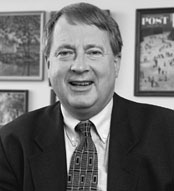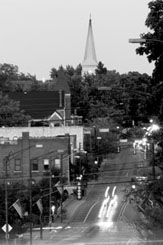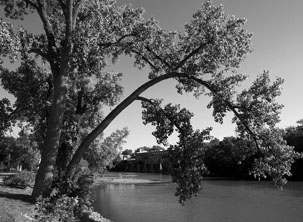 |

Batavia from Windmills to Accelerators by Sharon Butler That Batavia is Fermilab's home address is a quirk of history. Fermilab might have been in West Chicago, but Fermilab's founding director chose a post office box in Batavia instead. He was afraid that an address in West Chicago might confuse foreign visitors--they might think Fermilab was located on the outskirts of the Second City. Nevertheless, the choice was particularly apt. For, in one way or another, both are, or have been, in the business of energy: Fermilab, of course, is in the business of high-energy physics, splitting protons open at energy levels of a trillion electron volts to figure out what makes matter tick.
Last year's city sticker, on the windshield of every registered car in Batavia, featured a picture of the town's windmill, and of Fermilab's Wilson Hall. The town began with a solitary log cabin in 1833, and two years later became Batavia, when the property was purchased by Jude Isaac Wilson. Batavia was the name of Wilson's home town back in the old country. Blessed with a river to supply power and irrigation and surrounded by the rich farmland of the Midwest prairie, Batavia grew rapidly. By the middle of the eighteenth century, it had become a prosperous industrial center. About a dozen companies manufactured windmills, among them Challenge Windmill and Feed Company, U.S. Wind Engine and Pump Company, and the Appleton Manufacturing Company. Batavia was also rich in limestone. After Chicago's Great Fire, Batavia's 10 quarries supplied the stone to rebuild the city. Many buildings in Batavia's own downtown area are constructed from the rough-cut stone. This prairie town played an interesting role in the nation's history. Following the assassination of President Abraham Lincoln, his widow, Mary Todd Lincoln, spent three months in Batavia's Bellevue Place, then a sanitarium and rest home for the mentally ill. Here in Batavia, the first self-regulated automatically adjustable windmill was developed. Here, too, the now-ubiquitous flat-bottomed paper bag was invented, as well as a process for grinding grain against a metal rather than a stone surface. The nation's annual observance of Flag Day began in Batavia, credited to one of its dentists, Bernard J. Cigrand. And, of course, here in Batavia the top quark was discovered in 1995, at Fermilab. Today, Batavia's population is over 21,000, including many who work at the national laboratory, and the Lab is viewed as a welcome neighbor.
Luann O'Boyle, administrative assistant for the Sloan Digital Sky Survey group, has lived in Batavia for almost 20 years, and loves its small-town feel, a place where neighbor knows neighbor and volunteers help build staunch timber overlooks along the town's Riverwalk. "It's not so big that you feel lost," O'Boyle said. And Fermilab is just around the corner, contributing not only to the community's economy but to its annual cultural calendar with its Art Series offerings, like Ahmad Jamal and the Jellyeye Drum Theatre. The only downside, O'Boyle wisecracked, is that she has no excuse for arriving late at work: "I can't very well say I was stuck in traffic."
In the time he's lived in Batavia, however, he's seen a lot of growth beginning to threaten the way of life out here on the prairie. It's a constant theme of residents all across the Fox River Valley. Roger Dixon, who does research on cold dark matter, has the same complaint. He's been watching the town fight to maintain its community identity as it struggled to "stem the tide of surging urban sprawl and the invasion of Pave-all Creatures from the planet Mall-eron." He figures "the town can't win in the end because Steven Spielberg didn't write or direct this script."
The wide open spaces at Fermilab, though, are a palliative, he said, and keep development somewhat at bay--at least for now.
|
| last modified 9/17/1999 email Fermilab |
FRLsDFx9eyfrPXgV
 And Batavia used to be in the business of wind engines, or windmills, used for pumping water and later for generating electricity. The town's windmills appeared all across the American landscape, and still dot Batavia's lovely Riverwalk.
And Batavia used to be in the business of wind engines, or windmills, used for pumping water and later for generating electricity. The town's windmills appeared all across the American landscape, and still dot Batavia's lovely Riverwalk.
 "If Fermilab hadn't arrived, the whole area would be a subdivision now," said Batavia Mayor Jeff Schielke. "Fermilab has never smoked, polluted, blown up, smelled or caused traffic jams. Most people would say it's the best thing that ever happened to Batavia."
"If Fermilab hadn't arrived, the whole area would be a subdivision now," said Batavia Mayor Jeff Schielke. "Fermilab has never smoked, polluted, blown up, smelled or caused traffic jams. Most people would say it's the best thing that ever happened to Batavia."
 Bill Koncelik, in the Procurement Office, also likes the small-town feel. He moved here from congested Long Island 10 years ago, and never regrets it. He has no commute to speak of (one recent bright summer morning, he biked to work). And he enjoys all the family activities the community offers for his four- and eight-year-old.
Bill Koncelik, in the Procurement Office, also likes the small-town feel. He moved here from congested Long Island 10 years ago, and never regrets it. He has no commute to speak of (one recent bright summer morning, he biked to work). And he enjoys all the family activities the community offers for his four- and eight-year-old.
